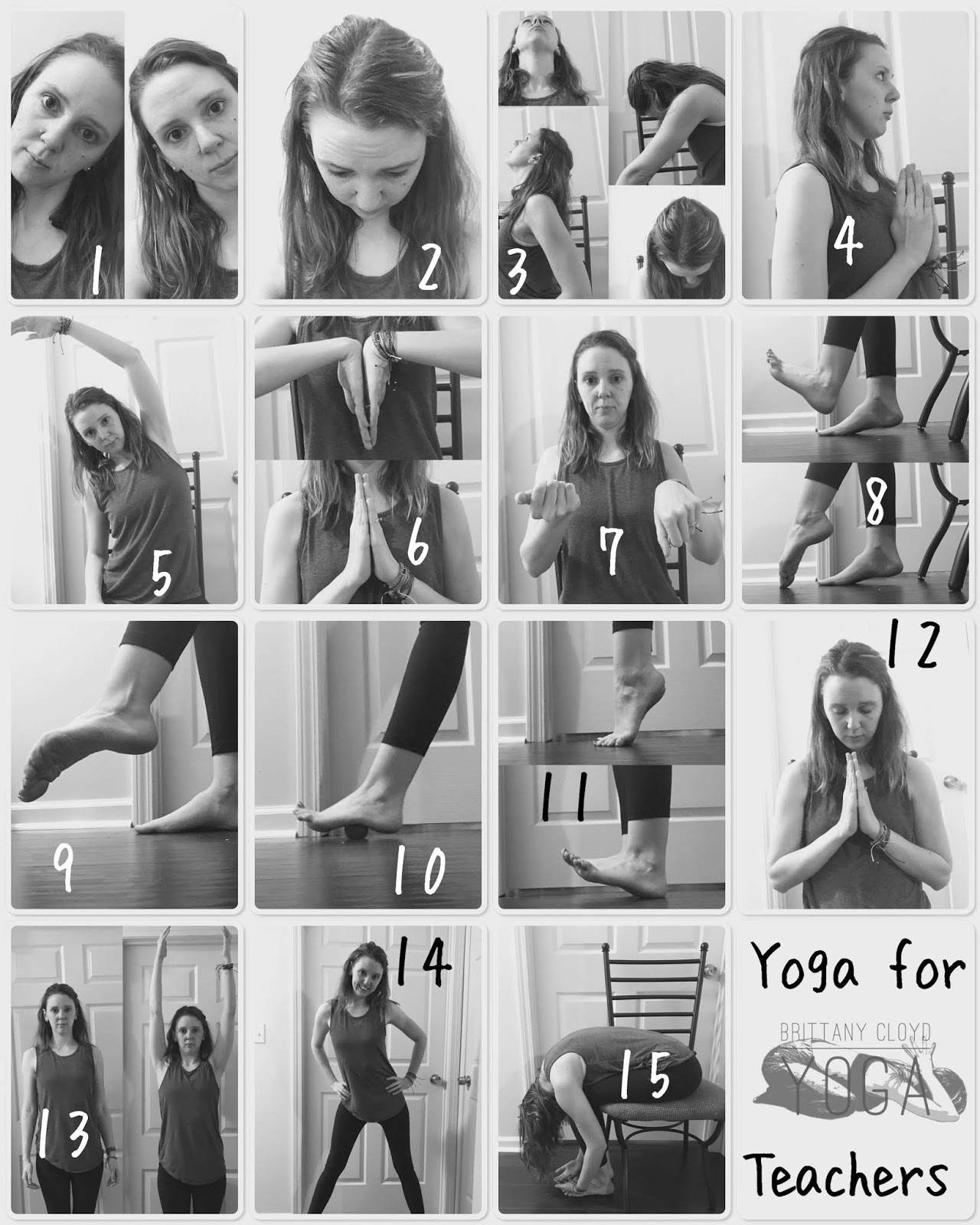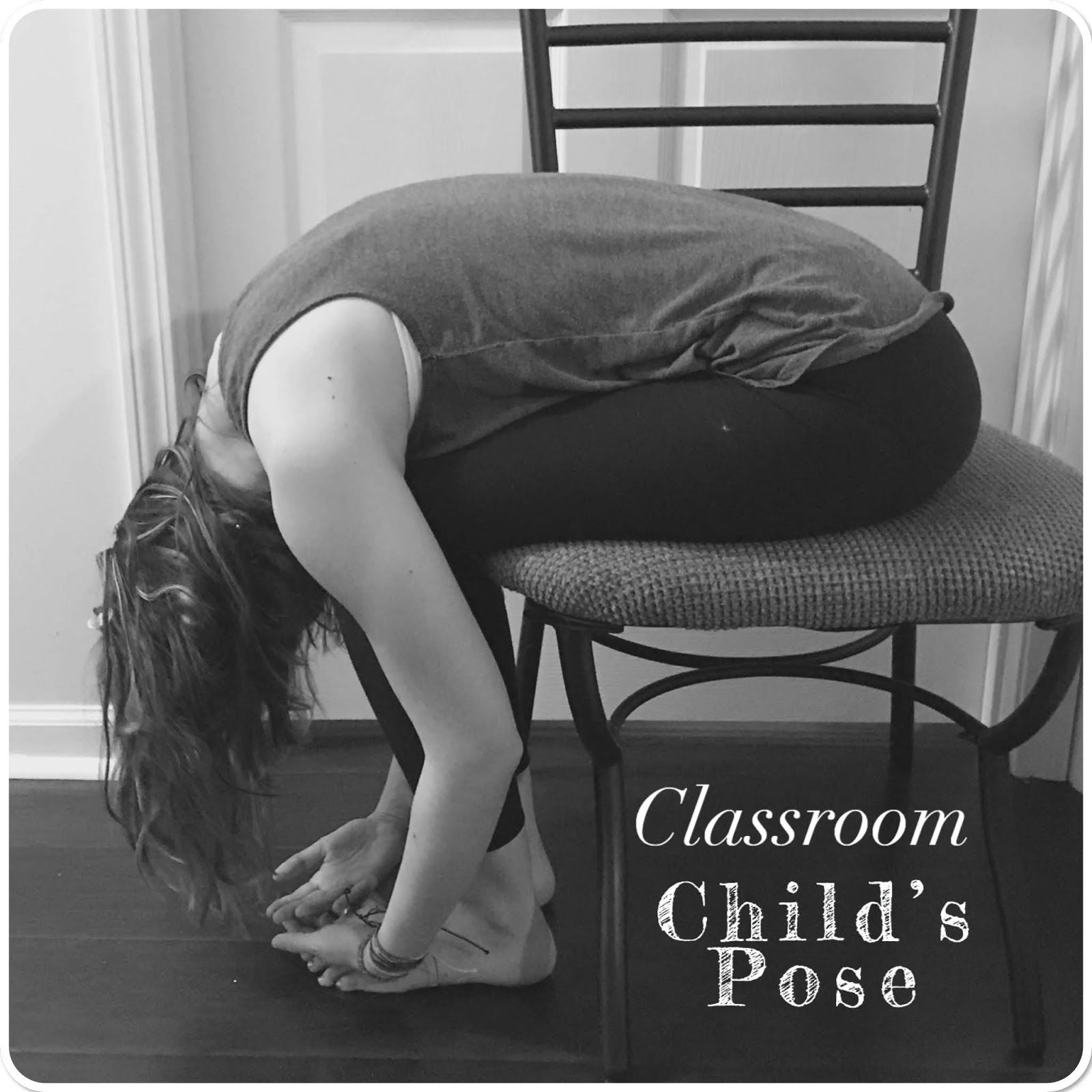Except for you year-rounders, most of us have been in school a few weeks now. The question is – did you follow the tips found in my last blog post, Put On Your Oxygen Mask First: Self-Care in the First Month of School (and the rest of the year, too!), or are you fueling your fire with the tears of your students, hanging by a thread? (Just kidding. If you are fueling with your students’ tears, you should be thriving!)

Though the 5 Quick and Easy Self-Care Methods were designed to break down barriers to self-care, you may think they’re so easy that you don’t have to give them a second thought. But burnout is real, and retirement is probably pretty far away. Getting through the days, weeks, months, and years, requires constant effort and mindful attention. Preserving your sanity should be your number one focus, because foregoing your oxygen mask will only lessen your ability to help your students succeed.
The first, and perhaps the most vital, of the 5 Self-Care Methods is chair yoga. Dismiss any preconceptions you may have about yoga, chair yoga, or the Instagram models in handstands on the beach. Yoga is an ages-old practice that spans cultures, geographic locations, and religions. Yes, yoga is a type of exercise or workout, but it has the potential to be so much more!
Whether you’re an active teacher who is constantly on her feet, moving around the room and interacting with her students, or a computer-based teacher who finds himself behind a desk for many hours a day, you may eventually discover joints that don’t move as smoothly as they used to, muscles that strain after a busy day, and a brain that feels overworked and lethargic. By adding a few, quick, yoga poses to your quick between-bells breaks, you can target these areas of chronic pain and stress, and take a few minutes to replenish your batteries.
The yoga poses in this post can be done by beginners with absolutely zero yoga experience. They can also be done in your classroom without any props. Some may be done seated – your desk chair works great! Others may be standing.

Yoga Poses for Tech Neck/Stiff Neck/Neck Pain
In this technology age, Tech Neck is a very common complaint. Whether or not you have tech neck, staring at a computer screen can definitely strain your neck!
1. Shoulder to Ear, seated or standing
Inhale to lengthen through the spine, sitting up tall. Exhale to drop your right ear toward your right shoulder. Inhale to bring head back to center. Exhale to the left. Repeat as many times as you’d like, or hold each ear-to-shoulder position for a few breaths longer.
2. Neck Circles, seated or standing
Beginning with small circles, drop chin toward chest and then rotate head in clockwise direction. Continue to breathe. When ready, switch direction to counterclockwise.
Yoga Poses for Low Back Pain
Low Back Pain is one of the most commonly diagnosed issues among adults. Improving your posture can help greatly with low back pain complaints, but even the best-postured individual can still encounter pain, especially if you’re standing/sitting all day.
3. Seated Cat/Cow
On inhale, pull your belly button toward your spine and round the shoulders and back, dropping the neck slightly, like an angry cat. On exhale, expand the belly and arch the upper back slightly, raising your gaze to the top of your computer, like a cow. Bonus points if you hiss and moo with the movement!
4. Seated Twist
Inhale to lengthen through the spine, sitting up tall. On the exhale, twist slightly to the right, keeping your hands at heart’s center or on your lap and not using them to pull you further. Inhale to come back to center, exhale to the left side.
5. Lateral Side Stretch, seated or standing
Inhale to lengthen through the spine, raising arms overhead. Exhale to bend to the right, lengthening the left side waist and shortening the right. Keep your torso facing the same direction as your knees. Inhale back to upright, and exhale to the left.
Yoga Poses for Wrist Pain/Carpal Tunnel Syndrome
With as many grades as a teacher has to enter into the computer, it’s no surprise that wrist pain is a common complaint!
6. Flex/Bend Prayer Hands, seated or standing
Press palms together near heart, shifting weight into wrist and then into fingers to stretch ligaments in wrist. Flip hands down, backs of hands against each other near heart. Again, shift weight between fingers and wrist.
7. Wrist Circles, seated or standing
Make fists or leave hands open, rotating wrists clockwise and then counterclockwise.
Yoga Poses for Ankle Pain/Tired Feet
On your feet all day? Then you definitely need to massage the joints in your ankles and stretch out your feet! No, not with more walking!
8. Flex/Point Foot, seated
While sitting, raise one foot off the ground. Alternate between flexing the foot (like you’re standing) and pointing the toes. Repeat with the other foot.
9. Ankle Circles, seated
While sitting, raise one foot off the ground. Rotate the ankle joint clockwise and then counterclockwise. Repeat with the other foot.
10. Tennis Ball Stretch, standing
Keep a tennis ball in your desk drawer for an added foot stretch/mini-massage! Take off your shoe and place the tennis ball on the floor. Roll the tennis ball under one foot while grounding down through the other foot. Repeat on the other side.
11. Rock on Heels, standing
Standing tall, roll up onto your toes, then shift weight back onto your heels. Rock between toes and heels while continuing to breathe.

Yoga Poses for All the Other Stuff (the exhaustion, the stress, the anxiety…)
What if your pain isn’t physical? What if you’re fighting exhaustion or stress? Don’t worry, there are yoga poses to help with those, too!
12. Seated Meditation/Breathing Awareness
Sit tall, with your sit bones grounded into the chair below you. Become aware of your breath, without changing the length of your inhales or exhales, but instead just noticing the movement of breath through the body. Rest your hands on your thighs or bring one hand to chest and one hand to stomach to feel the inhale and exhale. Close your eyes if you can steal a moment of quiet, and just be.
13. Standing Arms Flow
To help you gain awareness of your breath and slow your inhales and exhales, stand tall, grounding through your feet. Rest your arms at your sides. Inhale your arms overhead, exhale your arms back to your sides. Repeat with the breath.
14. Standing Hip Circles/Hula Hoops
Widen the feet a bit. Put your hands on your hips or out to a T. Soften the knees and pretend like you’re hula hooping! Rotate the hips in a circle. Switch directions. Or, pretend like you’re cross-country skiing by rotating the hips back and forth, moving your arms forward and backward with the motion. This one is extra great for mid-day stress relief because it usually incites a case of the giggles!
15. Seated Child’s Pose
Child’s pose is often deemed the resting pose for any yoga practice. If a practice is too challenging, too demanding, or too stressful, students are encouraged to find child’s pose and reconnect with their breath. Unless you keep a mat at school or have unusually clean school floors (yuck!), you probably don’t want to lay down. You can do child’s pose from your chair.
Sit back in your chair, slowly bring your upper body to meet the tops your thighs, and bring your arms toward the floor, resting them on your feet or letting them dangle. Breathe deeply, feeling the expansion through the back of your body. Think about letting the arms hang heavy and releasing any holding or tension in the neck or shoulders.
Child’s pose is a jack-of-all-trades for improving digestion, increasing flexibility, releasing head tension (headaches), awakening the nervous system, relieving fatigue or restlessness, and reducing back pain. For most of us, letting go isn’t a strong suit, but regularly letting go in child’s pose may be exactly what your body needs to get through the day, month, year, and until retirement!

This list does not claim to make any claims to specific conditions or ailments. As always, consult a doctor if you have any specific health issues or question whether you should perform these postures.

You may not find time for all of these poses in each day, but peppering your busy day with one or two postures to target your problem areas may reduce your stress level, fatigue, and burnout! Challenge yourself to throw a pose or two in each between-bells break. Reward yourself for a clean email inbox or timely-entered grades with another posture or two or three. Relax into Child’s Pose for 5 minutes on lunch. And at the end of the day, allow yourself a deep Savasana before bed.
Happy Teaching!
